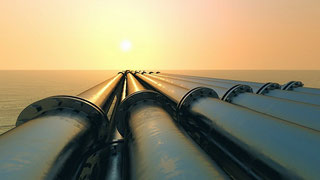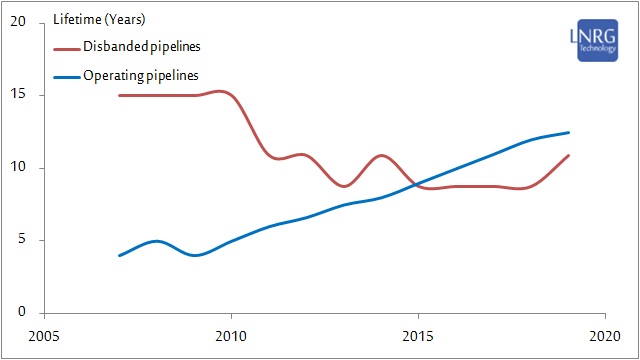
This study analyzes the 2020 operation statistics of Mideast hydrocarbon (oil and gas) pipelines with emphasis on inter-state midstream projects in order to assess the long-term financial feasibility of such projects and their correlation with regional geopolitical stability. The outcome from 2020 analysis is that seven inter-state Mideast hydrocarbon pipelines, which have already terminated operation, had been in use for a median lifetime period of 13 years. Furthermore, looking at the twenty currently operating inter-state hydrocarbon pipelines in the Mideast, it appears that their median operation lifetime to date is 13.5 years - both figures implying regional stability. Despite stabilization during the past five years, there is little certainty yet for long-term pipeline operational stability in the region.
The Middle East is known for the abundance of hydrocarbon resources and thus oil and gas pipelines have become an integrative part of the landscape. Almost every country in the Middle East has constructed some kind of pipeline infrastructure for internal purposes or connecting it with a neighbour. Furthermore, there are multiple projects of this kind being planned at various levels, beginning with various hypothetical pipelines in the Persian Gulf, continuing with potential export pipelines from Cypriot and Israeli gas fields and ending with grandiose trans-continental projects, such as Nabucco. However, from the very beginning, the Mideast pipeline business has been a gamble. For example, the Mosul-Haifa oil pipeline, constructed by the British in 1935 in order to transport oil from British-protected Kingdom of Iraq to Mandatory Palestine via British-protected Emirate of Transjordan, had operated for just 13 years, terminating upon British withdrawal from the region after World War II. In another example, the Trans-Arabian oil pipeline, running from Saudi Arabia to Lebanon via Transjordan and Syria, had operated for 17 years, failing to continue due to financial disputes. The Kirkuk-Banias oil pipeline had successfully surpassed five decades of continuous operation, though eventually terminating due to the 2003 Gulf War. Perhaps only the A-B oil pipeline from Saudi Arabia to Bahrain is an example of true long-term stability, running almost continuously from 1945.
This study analyzes the 2020 operation statistics of Mideast oil and gas pipelines with emphasis on inter-state midstream projects in order to assess the long-term financial feasibility of such projects and their correlation with regional geopolitical stability. Despite stabilization during the past five years, there is little certainty over long-term pipeline operational stability in the region. There have been multiple disruptions in Rehab branch of Arab Gas pipeline (AGP) from Egypt to Jordan over the past eight years, with partial operation capacity at present, whereas from among other branches of the AGP only the Ashkelon branch resumed operation by early 2020 at partial capacity. Furthermore, pipelines passing via Eastern Turkey have been targeted by insurgents during the ongoing PKK rebellion, sporadically terminating the flow. The Mosul-Kirkuk branch of the Kirkuk-Ceyhan oil pipeline (KCP) was sabotaged by Jihadists in 2013 and had terminated the flow until Iraqi Army return to the area in 2017, while the alternative Taqtaq-Peshkhabur branch running through the Kurdistan Region has already been attacked at least once. More recently, the A-B oil pipeline was attacked in November 2017, temporarily terminating the flow. The ongoing Persian Gulf crisis provided the latest set of disruption events, primarily targeting Saudi petroleum infrastructures, including pipelines.

Table 1. The median lifetime of operating and disbanded inter-state Mideast pipelines 2007-2020. The median period of operation for disbanded pipelines for 2020 is 13 years (absolute and normalized), while for operating pipelines the median operation lifetime is 12.5 years normalized (14 years absolute).
During 2019, several Mideast pipeline projects have progressed in planning and construction, including the planning of gas pipeline from Iraqi Kurdistan to Turkey, completion of the second Israeli-Jordanian gas pipeline, completion of the TurkStream gas pipeline and initiation of test flow, completion of TANAP and progress on new A-B oil pipeline. On the other hand, potential gas pipeline projects from Qatar to Turkey, Israel to Cyprus, Cyprus to Europe, discussions over possible Iraqi Kurdistan-Iran oil pipeline and the Nabucco project from Turkey to Europe have shown little progress.
The calculation of inter-state hydrocarbon pipelines lifetime in this study is combining the operating and partially operating pipeline lifetimes within a single category, but normalizing it by lifetime multiplied by available capacity. The above presented 2020 statistical analysis includes correction of AGP-Ashkelon branch operation lifetime due to pipeline operation renewal in early 2020, but excludes the second Israeli-Jordanian gas pipeline and TANAP which are still in the flow testing phase.

Figure 2. Mideast Pipelines Instability Index calculated from lifetime of operating and disbanded pipelines 2007-2020. Rise of the Index implies increasing regional instability, while decline into negative area implies stability and positive economic and geopolitical climate.
The outcome of 2019 analysis is that seven inter-state Mideast hydrocarbon pipelines, which had already terminated operation, had been in use for a median lifetime period of 13 years. Furthermore, looking at the twenty currently operating inter-state hydrocarbon pipelines in the Mideast, it appears that their median operation lifetime to date is 12.5 years. As for the currently operating inter-state pipelines - their lifetime could extend somewhat longer if no disruptions occur. This outcome is similar to the results of the previous Mideast hydrocarbon pipeline assessment published last year. While one can certainly assert that those statistics are somewhat non-representing, since most pipelines in the region have been inaugurated over the past two decades, there is still an interesting trend arising – showing that while 11-12 years inter-state pipeline lifetime is still a challenge, the current Mideast Pipelines Index implies regional stability for the near future.
The extended commercial report can be purchased at LNRG Technology digital store (below).
















